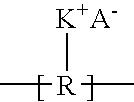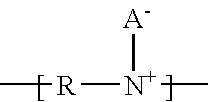Ionic polymer membranes
a technology of cellulose membranes and polymers, applied in the field of ionic polymer compositions, can solve the problems of cellulose membranes severely weakened, not achieving similar results, and being unsuitable for separating gases having approximately the same densities or molecular weight, etc., and achieve the effect of stable materials for membranes
- Summary
- Abstract
- Description
- Claims
- Application Information
AI Technical Summary
Benefits of technology
Problems solved by technology
Method used
Image
Examples
example 1
[0077] This example demonstrates preparation of a polymer composition from a co-polymer of. polyvinylpyrrolidone and polyvinylacetate (PVP-VAc). The co-polymer was purchased from Aldrich Chemical Company, Milwaukee, Wisc. 53566 USA (Catalog Number 19,084-5). The average polymer molecular weight (Mw) was 50,000 and consists of a 1 / 1 wt / wt mixture of vinylpyrrolidone and vinylacetate (1.3 / 1 molar ratio of pyrrolidone / acetate). The polymer was dried in a vacuum oven at 40° C. for 16 hours.
[0078] A 2.27 g portion of the dried co-polymer and 9.0 g methanol was placed in a 20 mL vial. The vial was capped and shaken for one hour to obtain a clear solution of the co-polymer in methanol. Next, 1.0 mL aliquots of the clear solution were added to each of four 2 mL tared vials. Open vials were placed on a hot plate at 40° C. for 18 hours during which the solvent methanol was allowed to evaporate slowly. A clear film was formed at the base of the vials and identified as PVP-VAc co-polymer. The ...
example 2
[0079] This example measures the non-selective absorption of a toluene / isooctane mixture on the co-polymer films of polyvinylpyrrolidone and polyvinylacetate (PVP-VAc) prepared according to Example A.
[0080] A stock 1 / 1 v / v mixture of toluene and isooctane (both HPLC grades from Aldrich) was prepared. About 0.3 g of the liquid mixture was added to each of four vials containing the PVP-VAc films prepared in Example A. The vials were re-weighed to four decimal places, and the net weight of liquid added calculated. A measured amount of the toluene / isooctane mixture was added to each of the four vials (average g liquid / g solid was 0.357 g / g). The vials were capped tightly and then shaken vigorously for one minute. The vials stood for 48 hours at room temperature. There was no significant change in the vial weights indicating that evaporation was less than about 2 percent. The refractive index of the four supernatants were measured and found to average 1.44177 (range ±0.0002) at 21.98° C...
example 3
[0081] This example demonstrates preparation of an ionic polymer composition from a co-polymer of polyvinylpyrrolidone and polyvinylacetate (PVP-VAc).
[0082] A 3.0 g portion of dried co-polymer and 20 mL methanol was placed in a 20 mL vial. The mixture was shaken for one hour at room temperature to obtain a clear solution of the co-polymer in methanol. Next, 0.84 mL of 70% nitric acid (13.0 mmol HNO3) was added via pipette to the clear solution and the mixture stirred for two hours with a small magnetic stir bar. Aliquots of the solution (2.0 mL) were added to tared 10 mL glass vials and the solvent evaporated under vacuum on a hot-plate at about 70° to 80° C. for four hours to form a solid ionic polymer. The vials were cooled and 2 mL of methanol was then added to re-dissolve the solid ionic polymer. The vials were then placed on a hot-plate at about 40° to 50° C. overnight (14 hours) to obtain clear, pale-yellow films of the ionic polymer, identified as (PVP-VAc) / HNO3, at the base...
PUM
| Property | Measurement | Unit |
|---|---|---|
| thick | aaaaa | aaaaa |
| thicknesses | aaaaa | aaaaa |
| outer diameter | aaaaa | aaaaa |
Abstract
Description
Claims
Application Information
 Login to View More
Login to View More - R&D
- Intellectual Property
- Life Sciences
- Materials
- Tech Scout
- Unparalleled Data Quality
- Higher Quality Content
- 60% Fewer Hallucinations
Browse by: Latest US Patents, China's latest patents, Technical Efficacy Thesaurus, Application Domain, Technology Topic, Popular Technical Reports.
© 2025 PatSnap. All rights reserved.Legal|Privacy policy|Modern Slavery Act Transparency Statement|Sitemap|About US| Contact US: help@patsnap.com



